Author: Daii Source: mirror
A global plunder in the guise of a procedure is quietly beginning.
In early July 2025, a motion document from the Delaware Bankruptcy Court in the United States, like a thunderbolt, hit the most silent group of FTX creditors in the world.
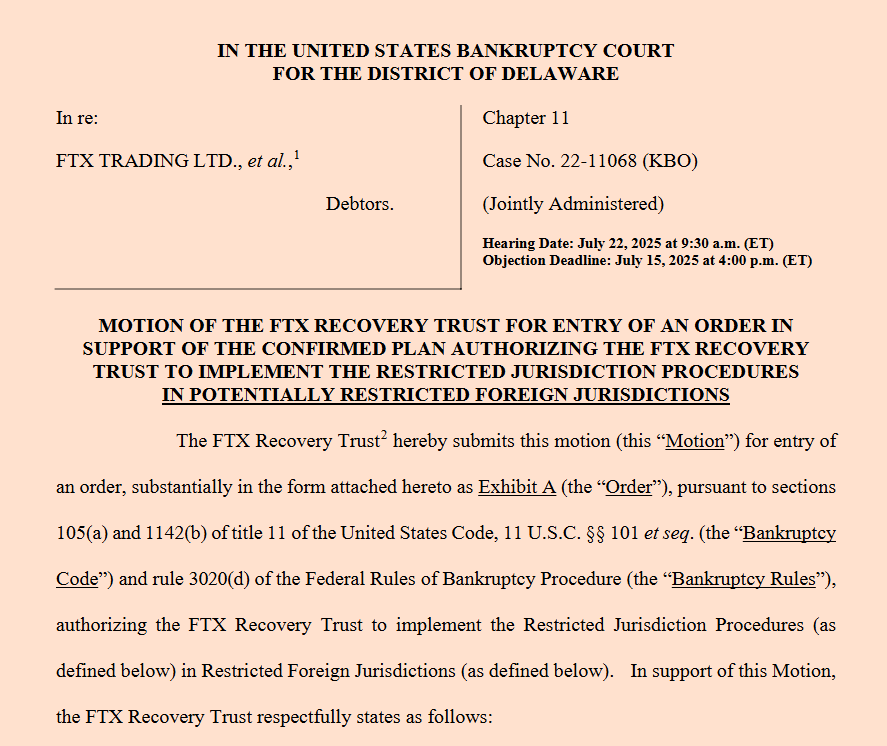
This seemingly rational and short motion is to obtain court approval for the "Restricted Jurisdictions Procedures". Once this procedure is initiated, creditors in 49 countries and regions, including China, may not receive any compensation.
From Mt.Gox to Celsius, from Voyager to Genesis, we have seen lengthy procedures and slow compensation, but we have never seen a bankruptcy compensation that openly lists a "prove your innocence first, otherwise you will automatically give up" level for creditors in 49 countries.
This is not a claim, but more like an exercise of "default confiscation".
We must see clearly: This is not just a legal game, but also a system collision - the globalization of Internet assets VS the localization of financial supervision. If this motion is passed in Delaware, similar bankruptcy trusts will take out this document as a "template".
You may still be watching, but the procedure has begun.
This time, we must fight on two fronts:
On the one hand, before the court hearing on July 22, we must do everything we can to block the motion itself and let the judge hear the voice of the restricted creditors;
On the other hand, if the procedure is really passed, we must initiate a class action lawsuit and hold the FTX Recovery Trust accountable for both breach of contract and infringement, so that the "confiscation cost" is far higher than the "reasonable compensation".
Justice should not be reversed by the procedure. This should be the awakening moment for FTX creditors in 49 countries.
Before that, we need to understand the ins and outs of this motion.
1. Why is there such a motion? ——From the perspective of FTX’s recovery trust
Opening the text of the motion filed with the Delaware Bankruptcy Court on July 2, 2025, we see the following opening statement:
FTX『s infamous prepetition business activities violated cryptocurrency-related laws and regulations in various countries around the world, often flagrantly. Today, certain creditors of the FTX Recovery Trust reside in jurisdictions that continue to have laws and regulations that restrict cryptocurrency transactions
“FTX’s prepetition business blatantly violated digital asset regulations in many countries around the world, and some creditors are still in jurisdictions that prohibit crypto transactions.”
This sentence is like a mirror, reflecting the sharp game between “losing money” and “breaking the law” - the recovery trust must choose between the two dilemmas.
1.1 Risky
Annex B of the motion lists 49 "potentially restricted jurisdictions", which account for about 5% of the total identifiable claims. Chinese creditors account for 82% of the value (Cointelegraph).
In these regions, there are at least 16 countries that prohibit crypto payments alone, and 9 countries have written digital asset payments into criminal law, with the most serious sentence being 10 years in prison (Cointelegraph). There is also the Tunisian case: in 2018, the central bank issued a comprehensive ban, and in 2021 a 17-year-old boy was arrested and prosecuted for "illegal foreign exchange transactions" simply for using cryptocurrency (AInvest). In this environment, a cross-border payment of compensation may touch on local criminal laws, trigger judicial assistance, or even "break the law across the border."
1.2 Not worth it
No matter how cold and hard the numbers are, they cannot escape arithmetic: the recovery trust can smoothly distribute up to about 95% of the claims, and currently only 5% of the claims are included in the "dispute pool" (technext24.com). If time and resources are spent on this 5%, not only will you have to pay lawyer fees, but it may also slow down the repayment of creditors who have passed. This is equivalent to "deducting" a certain proportion of the distribution from the interests of all creditors-no one wants to swallow this "time tax".
Under the Chapter 11 bankruptcy framework in the United States, the trustee is subject to the "Prudent Person Rule", that is, he can only undertake actions within the scope of "reasonable prudence", so it is extremely reasonable to give priority to protecting the interests of the majority of creditors. The motion has three "safety gates":
Such an arrangement, on the one hand, demonstrates respect for the procedural rights of creditors, and on the other hand, provides systematic operability, allowing judges to "preserve first, then evaluate", and also gives creditors ample opportunities to provide compliance evidence.
1.3 Summary
From the perspective of the FTX Recovery Trust, this motion is not a wall built out of thin air, but a serious "risk pricing": they try to balance compliance and compensation obligations within a controllable range, and classify the regions that may lead to criminal prosecution and huge delays.
However, you need to note that although this motion has no substantive actions, it only sets up a procedure - the restricted jurisdiction procedure. But the final result of such a procedure is that the creditors of the 49 countries and regions included in the candidate list will not get a penny in the end.
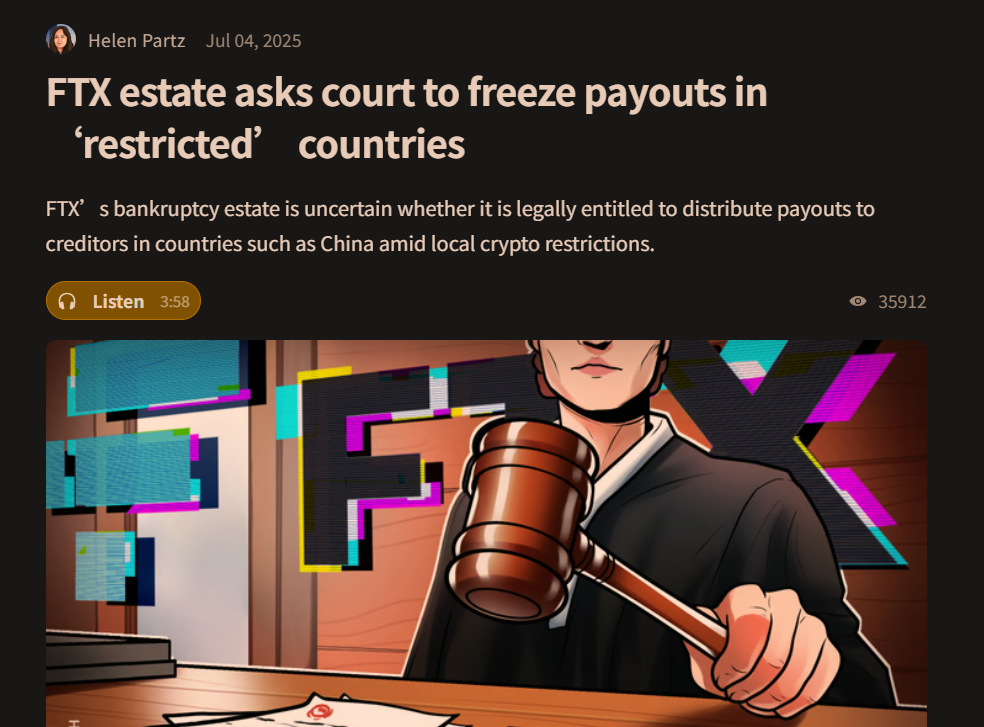
2. How to proceed with the restricted jurisdiction procedure? - A closer look at the "mechanisms" at each stage
This motion document, which is only 15 pages long, reads like a maze full of mechanisms. Each procedure is designed to seem reasonable and follow the rules, but it may push a legitimate creditor into the abyss of "automatic cancellation" without your noticing.
2.1 The first door: legal opinion
After the procedure is initiated, the Recovery Trust will hire "a qualified lawyer" in each country or region on the list to issue a legal opinion to determine whether the compensation conflicts with local laws and regulations. The motion clearly states: Only when the lawyer confirms that the payment is legal "without exceptions and without conditions", can the creditors in the jurisdiction unlock the eligibility for compensation.
However, the problem lies precisely in these six words - "without exceptions and without conditions". In many countries where digital asset policies are vague and the laws are not yet clear, which lawyer dares to endorse an unknown position? Not giving a reservation may jeopardize the professional license; giving a reservation will automatically be regarded as "unqualified" by the Recovery Trust. The design of this door essentially turns "default legality" into "default violation".
Thus, the common result of this compliance test is to receive a carefully worded "unacceptable opinion" with many reservations, and the procedure will move to the next stage.
2.2 The second door: 45-day objection window
When a country receives an "unacceptable opinion", the recovery trust will send a Restricted Jurisdiction Notice to the relevant creditors, notifying them that their claims may be invalidated. At this point, you only have 45 days to file an objection - and you must also submit a statement of commitment to waive additional procedural notices and accept the exclusive jurisdiction of the Delaware Bankruptcy Court.
On the surface, this looks like a reasonable opportunity for relief; but in fact, it sets two "invisible thresholds":
The first is the service issue. Many creditors used temporary mailboxes or overseas accounts when they registered for FTX, and the emails may have long been lost. If you do not notice this "fate-determining notice" within 45 days, the system will automatically regard it as "no objection" - the door is closed.
The second is the legal cost. In just one and a half months, you not only have to find a lawyer who understands local crypto laws, but also pay for him to write an affirmative legal opinion. This means thousands to tens of thousands of dollars in expenses in many countries. For small creditors whose amounts are not high, this is almost equivalent to "buying a redemption ticket for yourself with compensation."
2.3 The third door: Judge's ruling
If no one raises an objection, or the objection fails to pass the standard, the recovery trust will submit a brief motion to the bankruptcy court, formally applying to list the country or region as a Restricted Foreign Jurisdiction. This step will basically not be rejected, because the US courts tend to "respect the trustee's duty of care" intentionally or unintentionally.
So, once a signature is signed, starting from the next Distribution Record Date - even if you have already completed the claim declaration, even if the system has shown that you are an "Allowed Claimant", your claim will quietly change to "FORFEITED" (invalidated) in the background status bar.
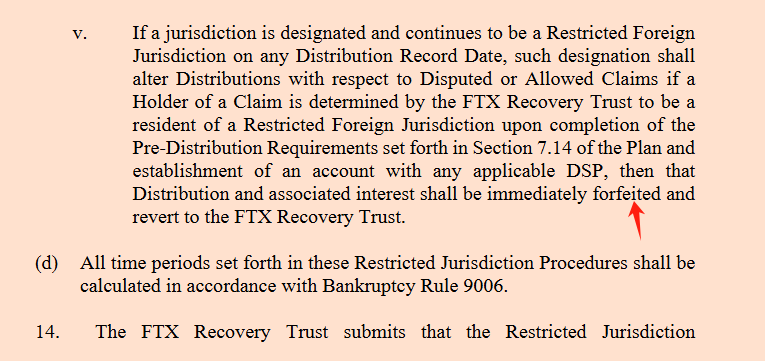
The motion is written very clearly: "Once the Court enters such an order, all affected claims shall be deemed automatically disallowed and expunged as of the next Distribution Record Date."
2.4 Summary: A seemingly reasonable procedure, but in fact full of obstacles
On the surface, this motion is nothing more than a technical arrangement for risk management - the lawyer's opinion, the appeal window, the court's ruling, each link seems to be legitimate and compliant, and even "procedural justice" to the extreme.
But when we disassemble them one by one, we will find that this process is very much like a cleverly woven "legal trap": each step seems to give you an opportunity, but in fact it is a slow countdown of "default invalidation".
3. Why is the "restricted jurisdiction procedure" a "legal" confiscation process?
To understand this step, you have to translate the "procedural language" in the motion into the "asset destiny language". On paper, it never says "confiscation"; but if you string together the entire process, you will find that everything it does is to legally, quietly, and irreversibly recover the deserved distribution of creditors in certain regions into the recovery trust pool within the legal framework.
3.1 Procedure trigger = transfer from "payable" to "dispute pool"
As long as a jurisdiction fails to obtain an unconditional and unconditional legal payment opinion from a local lawyer, the Recovery Trust can mark all claims in that jurisdiction as "Disputed Claims". This point is very clear in the motion text: after receiving an "Unacceptable Opinion", the Trust "is authorized to treat claims in these jurisdictions as disputed claims until the status is resolved." (CryptoSlate)
In other words, you were originally an "Allowed Claimant", but because the laws of your country are vague, you were downgraded with one click; the system sent you to the "waiting room", and the result of waiting is likely not to be paid, but to disappear.
3.2 Notice + 45 days of silence = "presumed waiver"
Next is the "45-day objection window" we just removed. The motion authorizes the trust to send a Restricted Jurisdiction Notice to the last address/email in the file, which is deemed to have fulfilled the "commercially reasonable service obligation". (CryptoSlate)
The truly cruel logic is: the program defaults to you being able to see the email; if you can't see it, it's your own problem. If you don't object after the deadline, it means that you are presumed to agree to be excluded from the payment. Cointelegraph pointed out this key point: the trust seeks court approval to "suspend payments to 49 potential restricted jurisdictions" and reminds creditors that if they do not act, they will lose their eligibility for distribution. (Cointelegraph, Cointelegraph)
3.3 Judge’s Signature = Local Legal Shield, Global Confiscation Gate
Once the objection period is over, the Recovery Trust will go to court to request that the jurisdiction be officially included in the Restricted Foreign Jurisdiction. Once the ruling is established, the sixth paragraph of the motion stipulates very harshly: from the next Distribution Record Date, the relevant claims in the jurisdiction will be "automatically not paid and deleted (expunged)", and the corresponding amount and interest will be "reverted to the FTX Recovery Trust".
This is the key action of "legal" confiscation - not directly robbing, but through judicial order, your claim qualification is legally erased before the record date, and then the money is properly transferred back to the trust pool.
CryptoSlate made a popular summary of this: the frozen amount and accumulated income of the creditor's rights that were not successfully objected or failed within the time limit "flow back to the estate". (CryptoSlate)
3.4 "Duty of Care" is the shield of the procedure - and also the knife of the passive loss of rights of creditors
Why did the court agree? Because the motion also applied to Sections 105(a) and 1142(b) of the Bankruptcy Law, Bankruptcy Rule 3020(d), and cited Paragraph 135 of the confirmation order: The court may issue any order "necessary or appropriate" to implement the plan.
Under this framework, the trust said that it was only fulfilling its duty of care: avoiding making payments in restricted areas, avoiding directors and officers from stepping on criminal liability minefields, and avoiding wasting assets to deal with foreign compliance. (Motion preamble + paragraphs 17, 20; Cointelegraph also cited “fines, personal criminal liability, risk of imprisonment.”) (Cointelegraph)
Don’t forget the real data: the 49 jurisdictions included in the watch list only account for about 5% of the total payable claims, but may slow down the payment of the remaining ≈95% of creditors; 82% of the affected value is concentrated in China, which is the single largest source of uncertainty. (Cointelegraph, CryptoSlate)
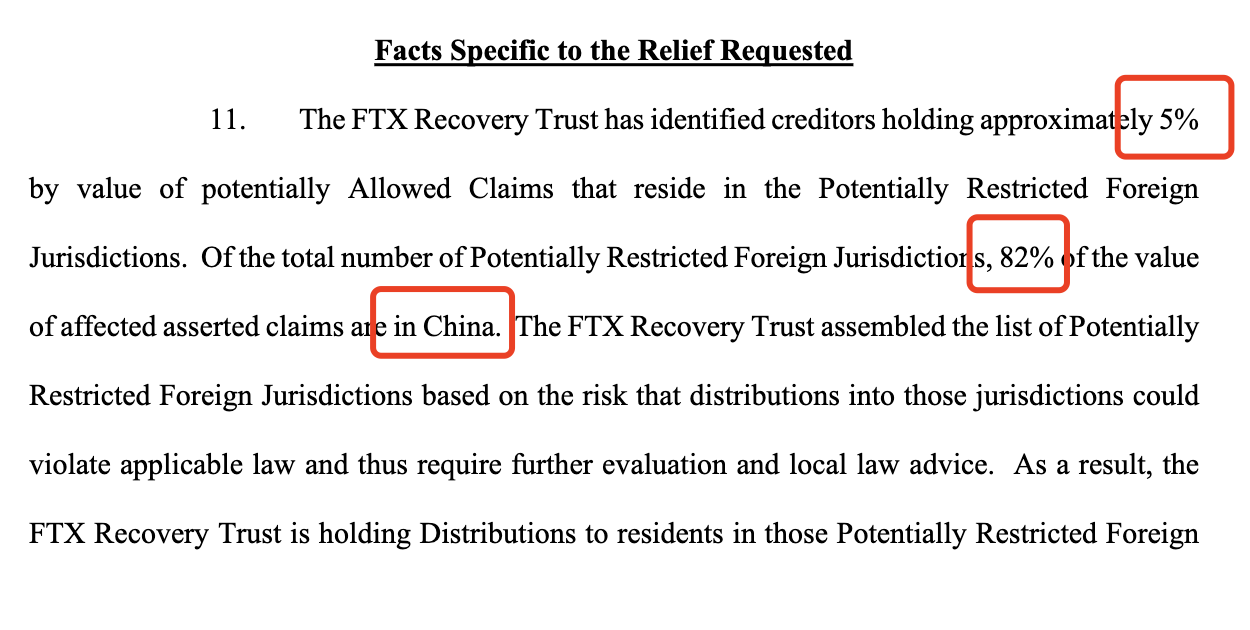
From the judge's perspective, supporting the trust "lock first and then try" seems to be protecting the majority - but the actual effect is to put a few people on the procedural slope, and once no one brakes in time, they will slide directly into the confiscation pool.
3.5 The global regulatory paradox of "can only do but not say"
The example given in the motion is not a random guess: a 17-year-old boy in Tunisia was arrested for an online crypto transaction, prompting the Minister of Finance to publicly express his consideration of "decriminalization"; this shows that in some countries, "the private sector is doing it, and the official dare not say it is legal." (CoinDesk)
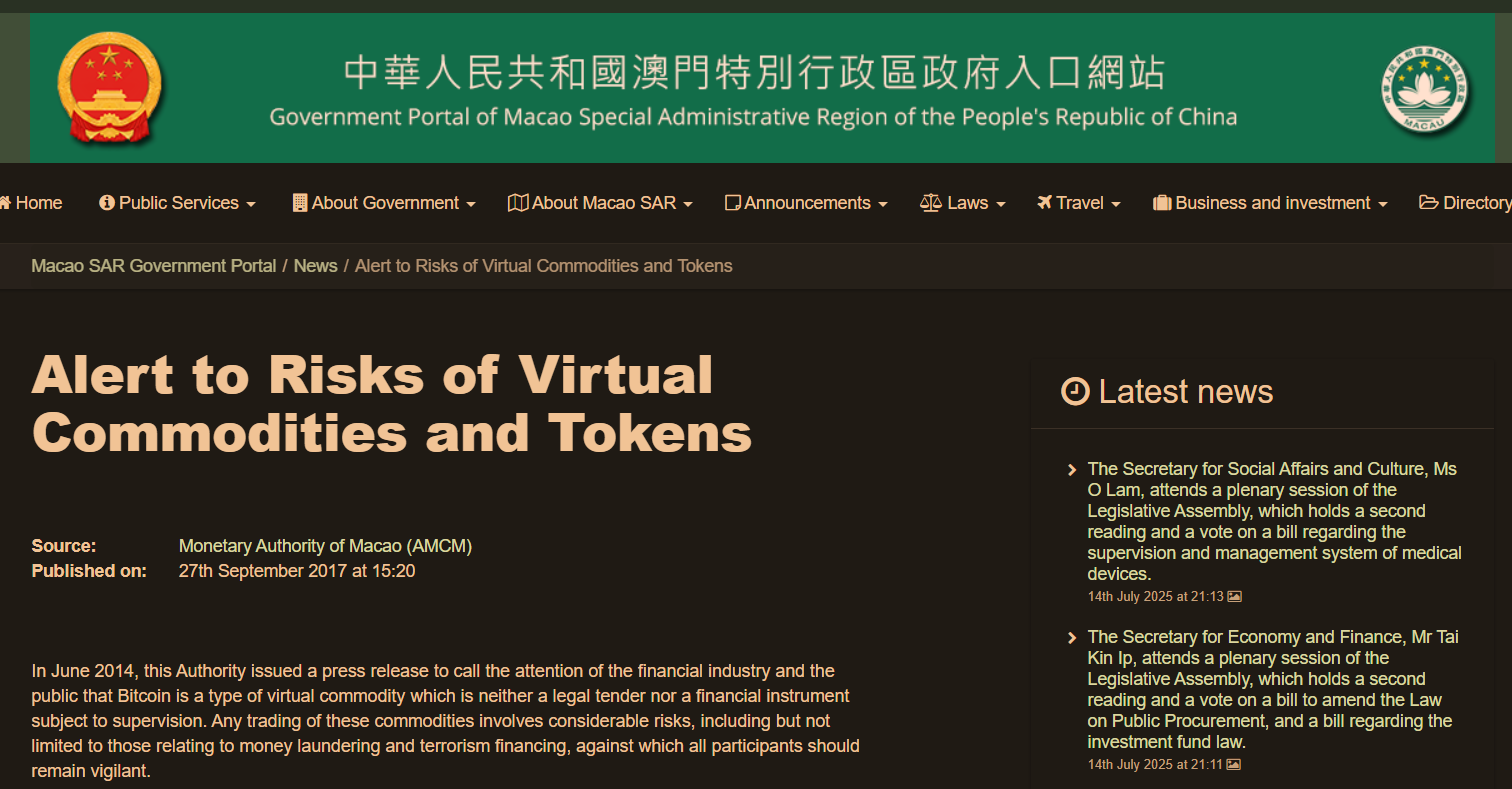
Looking at the Macau Monetary Authority as early as 2017, it reminded local banks that "it is not allowed to directly or indirectly provide financial services for token-related activities", indicating that "platforms pay residents" may be equated with illegal financial services. (Macao Special Administrative Region Government Portal)
At the Chinese level, the central bank's announcement in 2021 jointly with multiple ministries and commissions clearly stated that virtual currency-related business activities are illegal; overseas exchanges providing services to domestic investors are prohibited. Reuters also emphasized in a report in the same year that financial and payment institutions are not allowed to provide encryption-related services. (Reuters, Reuters)
Please imagine: you are in such a legal jurisdiction where you can "use it but not say it", and you ask the local lawyer to sign "completely legal and without reservation" - this almost requires him to gamble his future with his license. The rational choice of the lawyer is to have a conservative opinion; conservative opinion = failure in the procedure; failure = entering the confiscation track. The process design is here, and the logical loop is completed.
3.6 Summary: So, why is it like confiscation?
Because it is a structure of first suspension, then proof, then ruling, and then recovery:
Default risk;
Creditors provide evidence;
No certificate → loss of rights;
The funds are returned to the pool and legally redistributed.
The "restricted jurisdiction procedure" that the motion wants to pass does not have the straightforward phrase "take your money away", but it paves all the paths, allowing your money to be transferred in the background through "lack of certificate", "overdue" and "ruling". Legal in form, deprived in substance - this is "legal confiscation".
Of course, all crows are not black. FTX is not the first to compensate creditors after bankruptcy. Through other compensation cases and how other custodians protect creditors, you will find out how unauthentic the FTX Recovery Trust is.
4. Three cases tell you how unauthentic the "FTX Recovery Trust" is?
Of course, the "restricted jurisdiction procedure" proposed by the FTX Trust is not as reasonable as it seems. In order to make this process look "compliant", it must hide a premise: that is, globally, this unified ban and automatic cancellation of "gray zone" countries is an accepted and even common practice.
But the opposite is true.
Whether it is the Mt.Gox bankruptcy case, which was once larger and more complicated, or Celsius and Voyager, which are in the same wave of crypto exchange bankruptcy as FTX, these cases have not adopted such a radical one-size-fits-all model. The principle they follow is: even if compliance is complicated, we must do our utmost to protect the safety of creditors' assets, and even if compensation is slow, we cannot use the name of "procedure" to sneak the essence of "confiscation".
Let's take a look at these three iconic cases one by one to see how other projects still choose to stand on the side of creditors in a truly complex global legal environment - instead of using compliance as a barrier and procedures as scissors like FTX Trust. Chinese creditors, please study the last OKEx case in particular, which should be inspiring.
4.1 Mt.Gox: Ten years of long restructuring, but "confiscation if not given" has never been the default option

The bankruptcy restructuring of Japan's Mt.Gox took a ten-year detour: from the loss of about 850,000 BTC in the hacking incident in 2014, to the gradual recovery of assets and the entry into civil regeneration procedures, and then to the repayment of BTC, BCH and other assets in batches through multiple entrusted platforms starting in 2024.
Despite the uneven global regulatory standards and creditors around the world (about 127,000), Japan's reorganization trustee Nobuaki Kobayashi adopts a "multi-track parallel" model - allowing creditors to choose the receiving method from several cooperative channels: cryptocurrency (via virtual asset service providers such as Kraken, Bitstamp, Bitbank, SBI VC Trade, etc.), or bank wire transfer/remittance services, or even one-time advance and phased combinations.
Official notices repeatedly remind: creditors who fail to complete the "method selection + collection information registration" in time will delay or even be unable to receive payment - but this is "you can't get the money if you don't register", not "the money will be taken back to the pool if your country is not compliant." (Cointelegraph, CoinDesk)
More importantly, even if a cooperative channel cannot serve residents of a specific country due to its own regulatory commitments (Bitstamp's Mt.Gox support announcement clearly lists a long list of restricted regions, including China), the trustee still retains other feasible payment tracks (such as bank remittances, other entrusted exchanges), and does not convert such regulatory obstacles into "debt loss".
This is in sharp contrast to the one-way slope of "lack of reservations → 45 days of silence → judge's ruling → debt return to the trust" in the FTX motion. (CoinDesk, The Bitstamp Blog by Robinhood)
Looking at the execution level: Kraken announced the completion of the distribution of Mt.Gox BTC/BCH in its batch; Bitstamp subsequently started lending; the market was worried about the huge selling pressure, but there was no large-scale waiver of "forced inability to receive".
This shows that even in a complex cross-border and cross-regulatory environment, conflicts can be reduced through "multiple channels + longer preparation period + alternative options" without directly transferring risks to creditors' "procedural confiscation." (Cointelegraph, CoinDesk)
4.2 Celsius: Covering 165+ countries, 250,000+ creditors, complex distribution can also be done
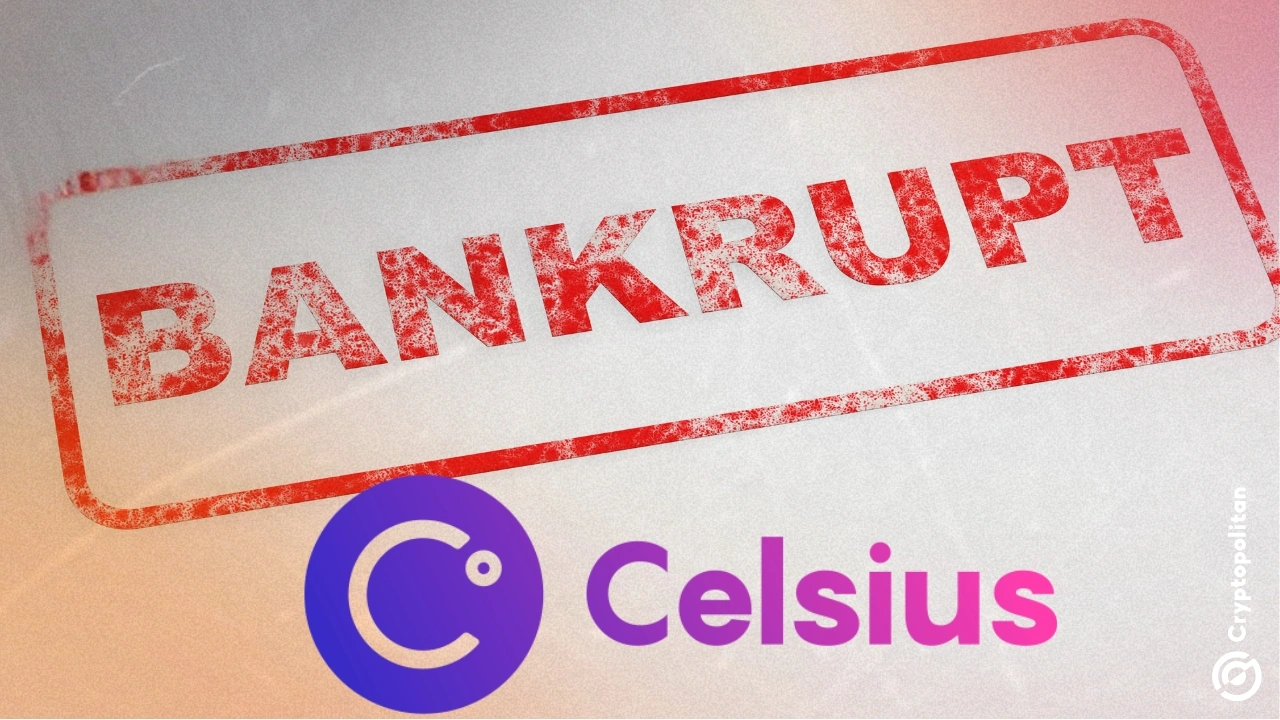
Celsius exploded in 2022 and entered the bankruptcy court procedure of the Southern District of New York; on January 31, 2024, it officially left bankruptcy protection and started the distribution process. Total planned amount: more than US$3 billion (crypto assets + fiat currency), and issued shares of the reorganized Bitcoin mining company Ionic Digital to creditors; the reorganization plan was supported by 98% of account holders in the vote. (Business Communications)
Implementation progress: As of the first status report in August 2024, the bankruptcy plan administrator has paid $2.53 billion (based on the 2024-01-16 pricing, including liquid crypto and cash) to more than 251,000 creditors, covering about two-thirds of all eligible creditors and 93% of the total value.
The bigger picture is that Celsius's distribution system is for about 375,000 creditors in more than 165 countries; its own complexity of "not being fully compliant before the case and being pursued by regulators in multiple countries" is described by official documents as "perhaps one of the most complex and ambitious distribution processes in the history of Chapter 11 cases." (CoinDesk)
And Celsius's operating logic is "trying to get the money to you", not "forget it if you can't find the way". The official/court-appointed agent (Stretto) continues to maintain a complete online support ticket system: What if I lose my original registered email address? Change the payment method? Multi-language instructions? These are listed in the FAQ and support documents, and it is clearly stated that "unfinished information -> postponed", not automatically confiscated. (Celsius Distributions, CoinDesk)
The distribution structure is not "all currency or all cash", but is adjusted according to the asset pool and regulatory feedback - including the centralization of altcoins that cannot be returned as is into BTC/ETH to simplify global distribution (the plan adds nearly $250 million in additional distributable crypto assets), and then combined with Ionic Digital shares; this kind of flexible combination aims to maximize the recovery rate under the restrictions of different jurisdictions, rather than using uncertainty to reduce claims. (Business Communications, CoinDesk)
4.3 OKEx Withdrawal Suspension: "Freeze First and Fully Open" in the Regulatory Gray Area

In October 2020, OKEx (now OKX) suddenly announced the suspension of all crypto asset withdrawals, citing the reason that "a private key holder is cooperating with the public security agency's investigation and is temporarily out of contact"; the incident occurred against the backdrop of China's high-pressure supervision and the exchange's "going overseas", causing panic among users around the world, especially in China. (Reuters, Nasdaq)
The platform freeze lasted for about five weeks. During this period, the market was concerned about the capital chain and law enforcement risks, but OKEx repeatedly emphasized that user assets were safe and trading functions were maintained as usual. Announcement on November 20: The problem has been resolved, and all asset withdrawals will be fully restored before November 27, and compensation/loyalty rewards will be introduced to appease customers; the announcement specifically reiterated that "100% reserves have been maintained, and unlimited withdrawals can be made after the blockade." (fintechfutures.com, Nasdaq)
Multiple reports and subsequent information show that the investigation storm originated from the Chinese law enforcement background; however, OKEx's choice is to "freeze for a short period of time for compliance verification, and let users withdraw after recovery", rather than long-term seizure or even confiscation in the name of supervision.
Even though the Chinese market is known as a "regulatory gray area" and "what can be done may not be said", the platform still uses the resumption of withdrawals + compensation activities to retain customers - this is in stark contrast to the FTX Recovery Trust, which directly pushes the debt into the path of "unprovable = automatically invalidated" when faced with regulatory uncertainty. (Nasdaq, fintechfutures.com)
4.4 Summary: Other cases "avoided the minefield", but FTX drew the minefield as a "waiver zone"
Putting the three cases together, you will find that the real difference is not how strict the supervision is, but whether the manager chooses to "solve the problem" or "make the problem your fault":
Mt.Gox: Regulatory fragmentation → multiple payment tracks + long registration cycle; limited channels ≠ invalidation of debt. (Cointelegraph, CoinDesk)
Celsius: Complex KYC in 165 countries → online support, flexible asset portfolio, continuous supplement of information windows; global distribution is still advancing over US$2.5 billion. (CoinDesk, Celsius Distributions)
OKEx: Hit by Chinese law enforcement → short-term security freeze, then full withdrawal and compensation for users; did not pass on gray area regulation to customers for permanent losses. (fintechfutures.com, Nasdaq)
On the other hand, FTX Recovery Trust: requires "no exceptions, no conditions" legal opinions - rare in reality; 45 days of silence on emails presumes waiver - a large number of small cross-border creditors find it difficult to respond; the judge "automatically expunges" the claims once he signs - the funds flow back to the trust pool and then divide them. The procedures are compliant on the surface, but in essence they are closer to "default confiscation under the guise of legality." (Cointelegraph, DL News, BitDegree)
5. Two-line battle plan for Chinese creditors
FTX's "restricted jurisdiction" motion is like a dense net that falls silently, covering creditors in 49 countries or regions around the world. At this moment, we who are in it have only two ways to go: one is to prevent this net from officially landing, and the other is to take the initiative to fight back when it really lands.
It's more of a survival instinct than a strategy. We can't wait for others to decide our fate.
5.1 The first line: blocking the motion before the trap is completed
From a procedural point of view, the motion submitted by Recovery Trust will be heard at 9:30 am (EST) on July 22, 2025. Although the deadline for submitting official objections has passed on July 15, it is still possible to claim "defective delivery" or "delayed knowledge" to apply for supplementary submission. Time is running out, but we still have a chance.
The key to blocking this motion lies in one point: major changes to the plan.
The content of the motion has made substantial changes to the original confirmation plan - it was originally said that "compensation can be obtained after completing KYC", but now it has added a clause "a lawyer must unconditionally confirm compliance", which is equivalent to temporarily changing the rules.
In addition to pointing out the problem, we must also propose solutions. Mt.Gox, for example, provides alternative payment methods with multiple channels. In some countries, it is not convenient to remit directly, so it is converted into legal currency or offline redemption; Celsius also allows creditors to choose different currency combinations to receive. We can advocate a similar mechanism instead of "confiscation if not given."
If we can push the judge to include a clause in the approval of the motion, that is, even if the payment is suspended, the funds must be retained in escrow and cannot be transferred back to the trust pool, then even if we cannot get compensation in the first time, our creditor's rights are at least alive.
This is our first front, which is a "defensive" short sprint. It would be best to win, but even if we cannot completely block it, we have already gained valuable preparation time for the second line.
Fortunately, Will has already submitted his objection on July 15.
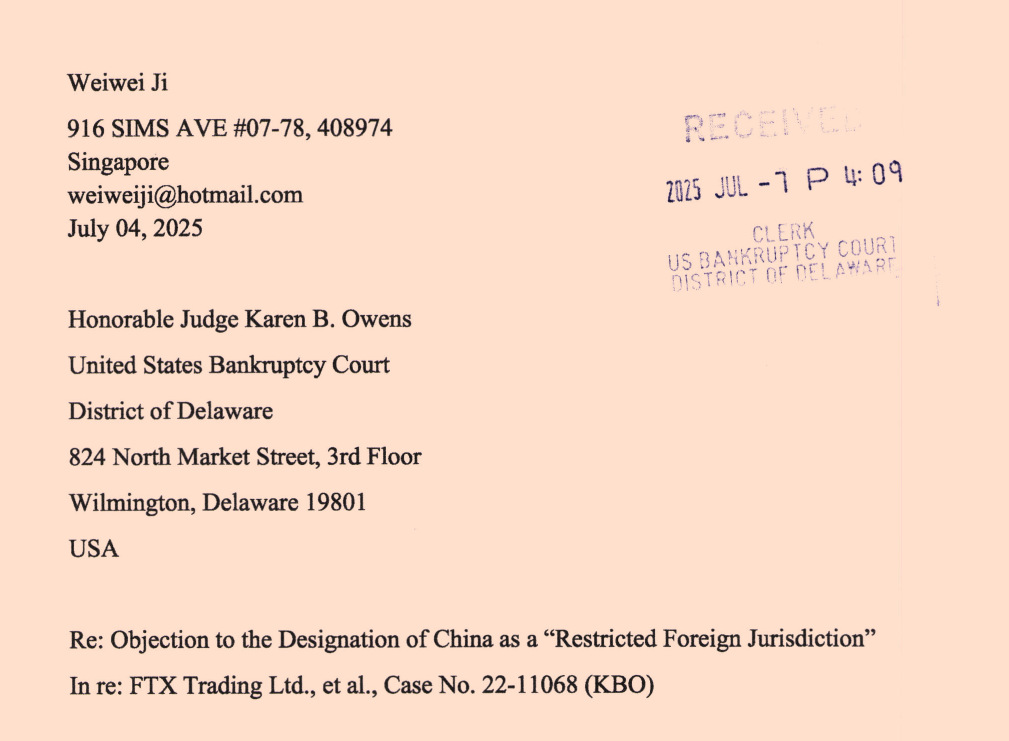
5.2 The second line: Take the initiative and make the cost of "confiscation" so high that they can't afford it
If the July 22 hearing ends with the motion being passed, the Recovery Trust will immediately start the next stage of the "restricted procedure" process. The 45-day objection window, the lawyer's opinion gate, and the confiscation clause are all in place.
Under such circumstances, relying solely on individual objections is not only costly, but also has a high failure rate. The truly effective way is to initiate an active class action lawsuit, suing FTX Recovery Trust head-on for breach of contract and infringement, and dragging them to the defendant's bench.
This is not an emotional catharsis, but a counterattack supported by sufficient legal basis.
The first is to confirm the breach of the plan. In the "Reorganization Confirmation Order" passed by the court on October 8, 2024, it is clearly stated that all creditors who have completed KYC have the right to distribution. However, the current motion attempts to terminate this distribution obligation on the grounds that "the legal opinion is not up to standard", and has not followed the amendment procedure prescribed by Section 1127 of the U.S. Bankruptcy Code. This is itself an illegal modification of the plan.
The second is a breach of fiduciary duty. The essence of the recovery trust is to maximize the recovery for all creditors, not just to serve creditors in "a few countries". It should remain neutral and should not set up procedural traps to deliberately invalidate certain countries.
The third is to constitute a civil tort. After the motion is passed, if the claims of a certain country are marked as "FORFEITED" (i.e., deemed to be abandoned) by the system due to "opinions not meeting the standards", the money will be directly "returned" to the trust for its own use. This is not only naked unjust enrichment, but may also constitute "conversion" - an act of illegally occupying other people's property.
5.2.1 Jurisdiction and actual operation: not just shouting, but also taking action
Some people may ask: Can we sue them in US courts? The answer is yes.
The main battlefield is still in the Delaware Bankruptcy Court, but we can choose New York or other courts with jurisdiction in parallel to initiate independent lawsuits on the grounds of "tort" or "contract breach" to circumvent various restrictions within the bankruptcy law framework.
Rule 23 of the Federal Rules of Civil Procedure of the United States stipulates that only five or more creditors are required to form a class action lawsuit to represent all creditors who have suffered losses in similar circumstances. This means that we do not need everyone to go to the battle in person, as long as we gather a representative "plaintiff group", the lawsuit can be initiated.
5.2.2 Freeze trust assets: Let the other party know that we are no longer passive
This lawsuit is not just a "theoretical victory", we can also use some effective tactics in the process-such as applying to the court for a "pre-judgment asset freeze" (pre-judgment attachment).
This is a legal means commonly used in cross-border financial disputes. Once approved by the court, we can temporarily freeze the US bank accounts, third-party recovery proceeds and other assets under the FTX Recovery Trust before the trial, preventing them from continuing to pay to the "compliant country".
A similar approach was also used in the Wirecard (German payment giant) case to freeze assets in London to ensure smooth progress in compensation negotiations.
This is not to prevent everyone from receiving compensation, but to show the trust: If they choose to be partial, we also have the means to make them pay the cost.
5.2.3 Public opinion and diplomacy: Let the "rule game" return to fairness and justice
In addition to legal means, we must also fight the "public opinion war" and "diplomatic war".
At present, Reuters and Bloomberg have explicitly mentioned that "Chinese creditors may be confiscated $380 million" when reporting on the motion, which has won us global attention. Next, we can further amplify our voices through more influential media such as BBC and AFP, emphasizing that this is not a dispute between China and the United States, but a global procedural discrimination issue.
At the same time, creditors of some affected countries can also submit letters of opinion to the U.S. Treasury Department (OFAC) or the U.S. Trustee through their own financial regulatory departments and diplomatic missions. This kind of "national intervention" is not uncommon in history - for example, in the TelexFree phone card fraud case, it was the intervention of the Brazilian Ministry of Foreign Affairs that ultimately led to the U.S. side agreeing to a joint compensation agreement.
5.3 Immediate Action: From Group to Battle Group
Once the motion is approved, we must immediately set up the "FTX Restricted Jurisdictions Creditors Committee" and publish a multilingual online recruitment form.
Select a US bankruptcy law firm with experience in class action lawsuits;
Initiate breach of contract and infringement lawsuits in Delaware and New York in parallel;
Apply to the court for an emergency injunction (TRO) to prevent the "restricted funds" from being redistributed to creditors in compliant countries.

At the same time, it is recommended that the current main group of rights protection initiates donations in a timely manner to ensure that the lawsuit can proceed smoothly. I and the "Airdrop Reference" project will donate 1,000 USDC respectively.
5.4 China's key role: not for itself, but for everyone
We must be soberly aware that Chinese creditors do face the highest threshold. Lawyers are reluctant to issue "unqualified opinions" and regulatory policies are highly uncertain. This is bad, but it also means that once Chinese creditors win an "alternative path" or "delayed custody" arrangement, the other 48 countries will naturally benefit.
We are not fighting for privileges for a country, but opening up a possible new rule for the world.
Because as long as the "ice block" of $380 million in China is broken, the other countries with a passive 1% to 2% share will lose the reason to be ignored by the trust.
From a cost perspective, this is even more cost-effective for the trust: rather than risking being sued, freezing assets, and being besieged by the media, it is better to spend less money to reach an agreement.
5.5 Final reminder: Don't let the procedure cover the face of justice
FTX Recovery Trust is not an organization without risk control logic. It can even be said to be a model of "acting in accordance with the law" - but that is the most terrifying part.
Because it is these seemingly perfect procedures that quietly turn our debts into objects of "system confiscation." Once the process starts, your silence is equivalent to giving up.
Blocking a motion is a sprint against the clock; while litigation counterattack is a marathon of endurance and wisdom. But as long as we take action and form a coalition, we can make the cost of the "automatic cancellation" game far exceed their budget.
This is a Chinese creditor version of "Robin Hood Operation".
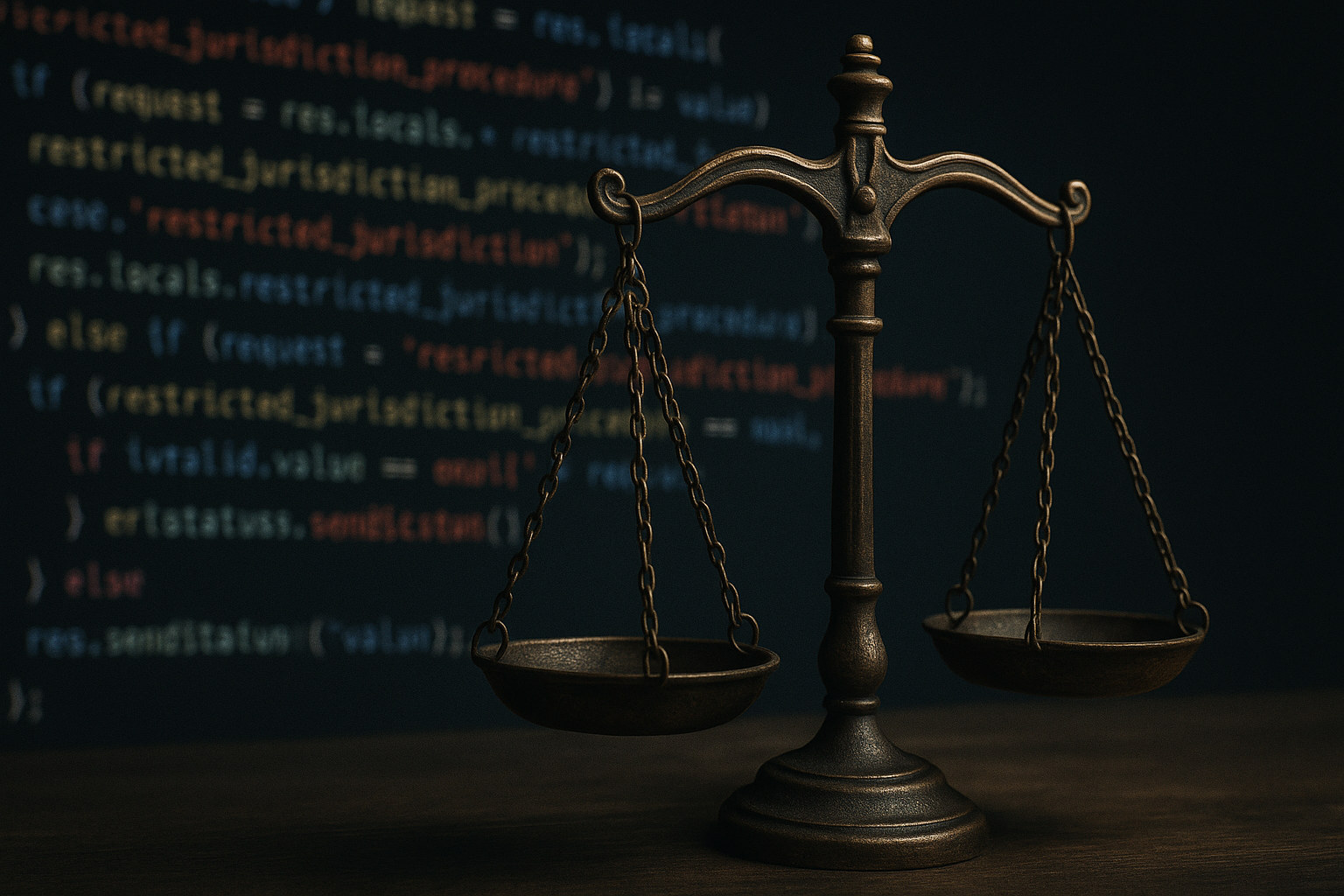
Conclusion|Justice cannot be "deducted" by procedures
The "restricted jurisdiction procedure" of the FTX Recovery Trust, on the surface, is covered with a compliance coat, but in fact it is a structural exclusion mechanism: in the reality of the separation of global asset flows and local laws, it regards the procedure as a barrier rather than a channel.
If this "no lawyer's opinion = automatic abandonment" model is ruled legal in Delaware, it will no longer be just a liquidation experiment, but a template for the systematic deprivation of cross-border creditors in future crypto bankruptcies.
This is not compliance, this is "assuming you are breaking the law"; it is not a legal procedure, but a "legalized confiscation".
Don't forget that all of this is built on the global regulatory fog. For example: In the 2021 Joint Regulatory Notice, although China prohibits financial institutions from participating in virtual currency business, it has never explicitly prohibited individuals from holding and trading; Macau warns of the risks of token trading, but there is no criminal punishment; although Tunisia has individual law enforcement cases, it lacks a unified judicial interpretation.
For these countries, "available but not available" has almost become a realistic portrayal.
In this gray area, it is essentially a luxury to want to find a "no exception, no condition" lawyer's opinion.
The procedure was originally a sword to protect the law, but now it has become a shame cloth. When the procedure becomes a filter, excluding the weak from justice, it is no longer a rule, but a tool. Today, a small number of people in 49 countries are restricted, and tomorrow it may be any asset in your hands.
I show two resistance paths:
Line A: Block the motion and demand trusteeship or alternative compensation;
Line B: Immediately counter-sue after the motion is passed, freeze the trust assets, and force them to renegotiate.
This is not an emotional confrontation, but a counterattack within the system. This is also a "awakening moment" for cross-border creditors: If we don't speak up at this moment, this template will be replicated repeatedly in the future; But if we stand up at this moment, it will become the first case of anti-procedural discrimination written by global creditors.
Because:
The program is to protect justice, and should not be a tool to filter justice.
 Brian
Brian
















